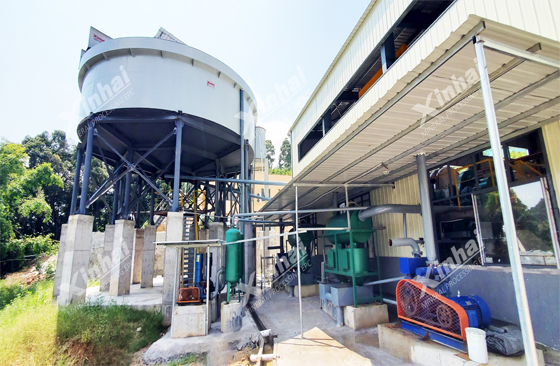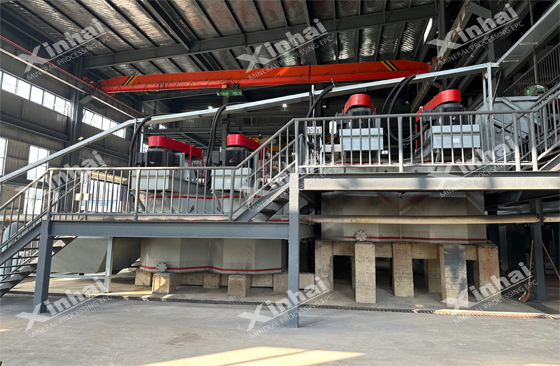
Phosphate rock, which is an important raw material for fertiliser production and numerous industrial applications, occurs rarely in pure form suitable for direct use. It is mostly associated with gangue minerals such as silica, clay, carbonates, and occasionally even heavy metals and radioactive elements. For economic viability and environmental control, hence, phosphate ores must undergo beneficiation—the processing of phosphate rocks to increase phosphorus content and eliminate impurities.

Understanding Ore Types: The Foundation for Process Selection
Before any processing scheme is selected, it is essential to examine the mineralogical characteristics of the phosphate deposit. Phosphate ores may be broadly classified into sedimentary, igneous, and carbonate-rich types with certain processing problems.
Sedimentary phosphates are the most widespread and generally finer grained, generally with high clay, quartz, and organic matter contents. These ores create slimes when milled, which interfere downstream flotation efficiency. A process solution to sedimentary phosphate typically entails desliming and direct flotation with fatty acid-based collectors.
Igneous phosphate ores are coarser in texture and may consist of magnetic minerals such as magnetite or ilmenite. Such ores are commonly treated by magnetic separation and flotation. These ores require strong grinding systems as these ores possess higher hardness. Carbonate-type phosphate ores contain dolomite and calcite, and these are chemically similar to apatite and more difficult to float. For these circumstances, flotation must be optimized through pH adjustment and selective reagents. In some circumstances, other treatments like acid leaching or calcination must also be employed.
Primary Beneficiation Processes for Phosphate Ore
Crushing and Grinding
The first operation in phosphate upgrading is to reduce the ore drilled to a size manageable using jaw or cone crushers. The crushed ore is afterwards milled using rod or ball mills to break up apatite particles from gangue. Based on mineral texture, grind size may range from as low as 75 microns down to finer.
Desliming and Classification
After grinding, the slurry can bear the majority of ultra-fines or slimes—in sediments ores, particularly. Such particles have been noted to decrease the efficiency of flotation by way of excessive reagent consumption and slime coating of particles. Desliming is often done with hydrocyclones or thickening tanks for the removal of particles under 20 microns.
Flotation
Flotation remains the most common practice in the concentration of phosphate ores, specifically of sedimentary deposits. The flotation process employs surface-chemistry differences to selectively concentrate apatite from carbonates, clay, and quartz. This is carried out by conditioning the slurry with collectors (usually fatty acids), pH adjusters (like sulfuric acid or lime), and depressants (such as sodium silicate or starch).
Depending on the ore complexity, the flotation circuit may be of various stages like roughing, scavenging, cleaning, and re-cleaning to attain maximum recovery and concentrate grade. Reverse flotation or multi-stage reagent regimes can be employed in carbonate ores. Magnetic Separation and Advanced Techniques
During phosphate processing of igneous origin, iron-titanium impurities are eliminated via magnetic separation. Thermal calcination or chemical leaching is utilized for harder ores to reduce the content of carbonate or improve recovery of P₂O₅.

Processing Plant Design: From Flowsheet to Full-Scale Operation
Planning a phosphate processing plant involves more than the selection of the most suitable equipment. It requires an integrated approach involving material handling, reagent preparation, water management, tailings disposal, automation, and environmental control. Process Flow and Layout Design
An acceptable plant layout traditionally has the following divisions:
Crushing and screening
Grinding and classification
Desliming and thickening
Flotation and concentrate filtration
Tailings thickening and water recycling
Reagent dosing and storage facilities
Control room, laboratory, and maintenance space
The flowsheet of the process should be designed to suit the individual ore characteristics and expected variability. Flexibility is essential—modular circuits, bypasses, and scalability must be incorporated into the design to accommodate future expansion or changes in ore quality. Infrastructure and Utility Requirements
The most important infrastructure components are:
Consistent power supply
Process water intake and return systems
Tailings storage facilities with environmental controls
Worker housing and site access roads (particularly for remote sites)
Rainwater and stormwater management
Water conservation and energy efficiency are fundamental design requirements. Closed-loop water circuits, variable frequency drives, and high-efficiency pumps are becoming the standard in modern phosphate plants.
Operations, Optimization, and Cost Control
In order to achieve long-term plant performance, process optimization and operations discipline have to be adhered to on a continuous basis.
Process Monitoring and Control
New phosphate plants use online analyzers to measure particle size, pH, reagent concentration, and froth quality in real time. These are fed into automated control systems (DCS or PLC-based), allowing precise adjustments and improved reagent efficiency. Maintenance Strategy
Preventive and predictive maintenance is required to avoid costly downtime. Technologies such as vibration monitoring, thermal imaging, and remote equipment diagnostics allow early detection of issues before they become serious problems.
Energy and Reagent Efficiency
Grinding tends to be the most energy-intensive process in phosphate processing. Practices like optimized ball charge, improved liner design, and use of energy-efficient classifiers can significantly reduce energy requirements.
Reagent consumption is the other major operating cost. Through continuous dosing optimizations and exploiting newer reagent chemistries, plants can increase flotation selectivity at reduced cost.

Tailings Management and Environmental Considerations
As environmental regulations become more stringent, phosphate facilities must adopt whole plant waste and water management practices.
Tailings, which are discarded gangue material and process water, are normally subjected to thickening, filtration, or dry stacking. High-rate thickeners, tailings filters, and lined storage ponds are now routinely installed in most plants to minimize seepage and environmental risk. Process water is wherever possible, recirculated, with closed-loop systems achieving recovery rates of over 85%. In arid climates, evaporative recovery systems and dry-stack tailings are gaining popularity.
Air quality, noise control, chemical storage, and restoration of biodiversity around the plant site are other considerations that are dealt with in comprehensive environmental impact assessments (EIAs).
With lower ore grades, rising costs of operation, and stricter environmental rules, phosphate beneficiation is not just a step in the process anymore—today, it's a competitive advantage. A competent beneficiation plant, along with the geology of the ore and optimized through real-time data and state-of-the-art automation, is required to remain competitive and profitable.
Whether you are constructing a greenfield phosphate plant or expanding an existing one, the success of your beneficiation plant will decide the efficiency, sustainability, and quality of your overall phosphate supply chain.
Copper mining in Africa? It's a really important and ever - changing part of the continent's economy. Thanks to all the new tech and the global push for clean energy, there's a ton of potential for growth. But if Africa wants to make the most of its copper resources in the long run, they've got to figure out how to fix these infrastructure, energy, and regulatory problems. Otherwise, all that potential might just slip through their fingers.
Xinhai has long been at the forefront of designing and implementing state‐of-the‐art mineral processing solutions. This article provides an authoritative overview of modern gold ore beneficiation methods, highlighting the technological advances that drive increased recovery, reduced environmental impact, and cost-effective processing.
